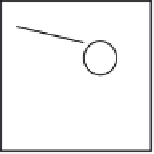Graphics Reference
In-Depth Information
screen and moves to the right side in one-sixtieth of a second and moves back to the left side in another
one-sixtieth of a second. This means that every thirtieth of a second (the rate at which frames are cal-
culated and therefore the rate at which positions of objects are sampled) the object is on the left side of
the screen. The entire motion of the object is missed because the sampling rate is too low to capture the
high-frequency motion of the object, resulting in temporal aliasing. Even if the motion is not this con-
trived, displaying a rapidly moving object by a single instantaneous sample can result in motions that
appear jerky and unnatural. As mentioned in
Chapter 1, Section 1.1
, images of a fast-moving object can
appear to be disjointed, resulting in jerky motion similar to that of live action under a strobe light (and
this is often called
strobing
).
Conventional animation has developed its own techniques for representing fast motion. Speed lines
can be added to moving objects, objects can be stretched in the direction of travel, or both speed lines
and object stretching can be used [
9
] (see
Figure A.9
)
.
There is an upper limit on the amount of detail the human eye can resolve when viewing a moving
object. If the object moves too fast, mechanical limitations of muscles and joints that control head and
eye movement will fail to maintain an accurate track. This will result in an integration of various sam-
ples from the environment as the eye tries to keep up. If the eye is not tracking the object and the object
moves across the field of view, receptors will again receive various samples from the environment inte-
grated together, forming a cumulative effect in the eye-brain. Similarly, a movie camera will open its
shutter for an interval of time, and an object moving across the field of view will create a blurred image
on that frame of the film. This will smooth out the apparent motion of the object. In much the same way,
the synthetic camera can (and should) consider a frame to be an interval of time instead of an instance in
time. Unfortunately, accurately calculating the effect of moving objects in an image requires a non-
trivial amount of computation.
To fully consider the effect that moving objects have on an image pixel, one must take into account
the area of the image represented by the pixel, the time interval for which a given object is visible in that
pixel, the area of the pixel in which the object is visible, and the color variation of the object over that
time interval in that area, as well as such dynamic effects as rotating textured objects, shadows, and
There are two analytic approaches to calculating motion blur: continuous and discrete. Continuous
approaches attempt to be more accurate but are only tractable in limited situations. Discrete
approaches, while less accurate, are more generally applicable and more robust; only discrete
approaches are considered here. Ray tracing is probably the easiest domain in which to understand
the discrete process. It is common in ray tracing to generate more than one ray per pixel in order to
Speed line
Speed lines and object stretching
FIGURE A.9
Methods used in conventional animation for displaying speed.












Search WWH ::

Custom Search